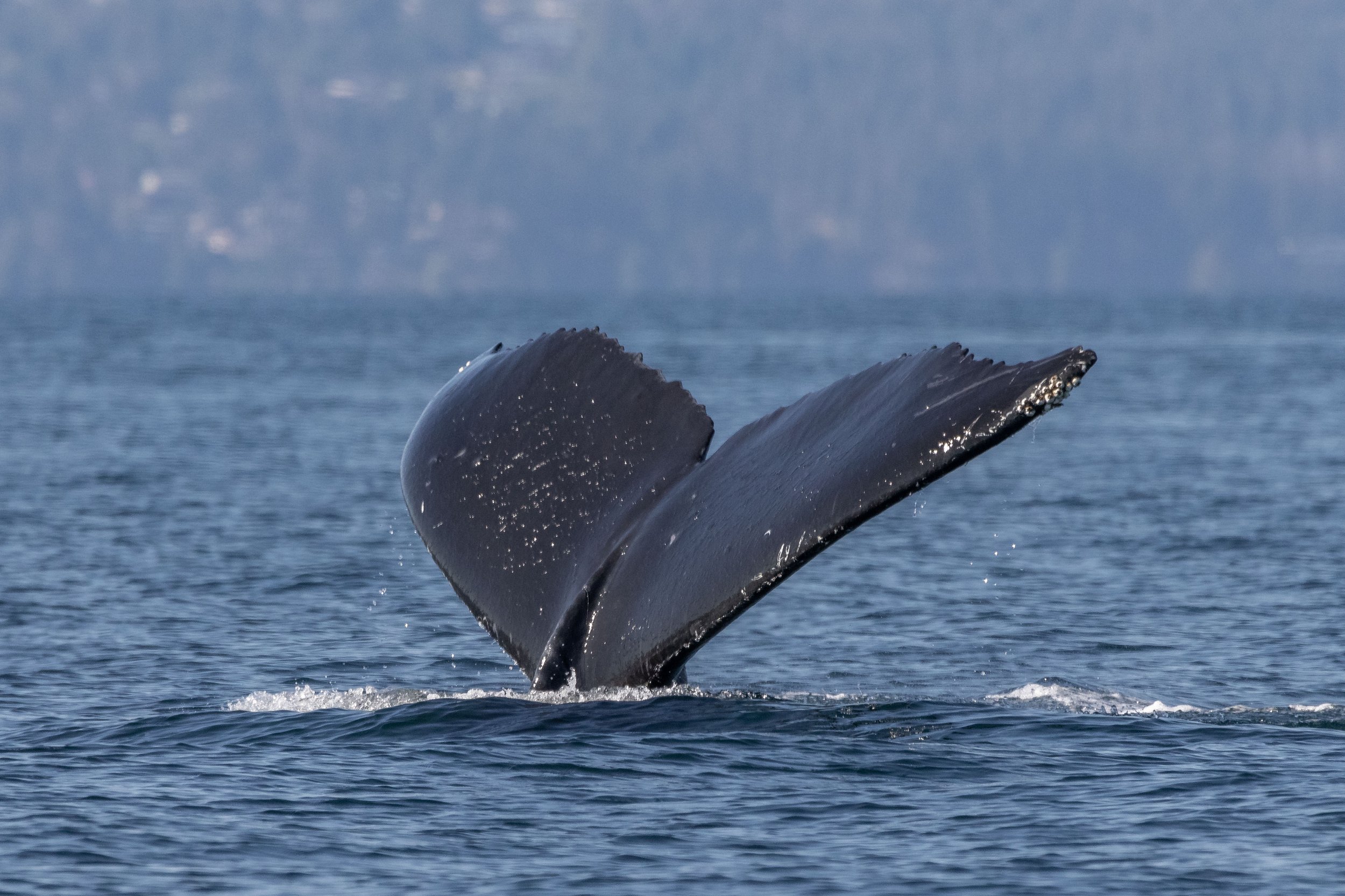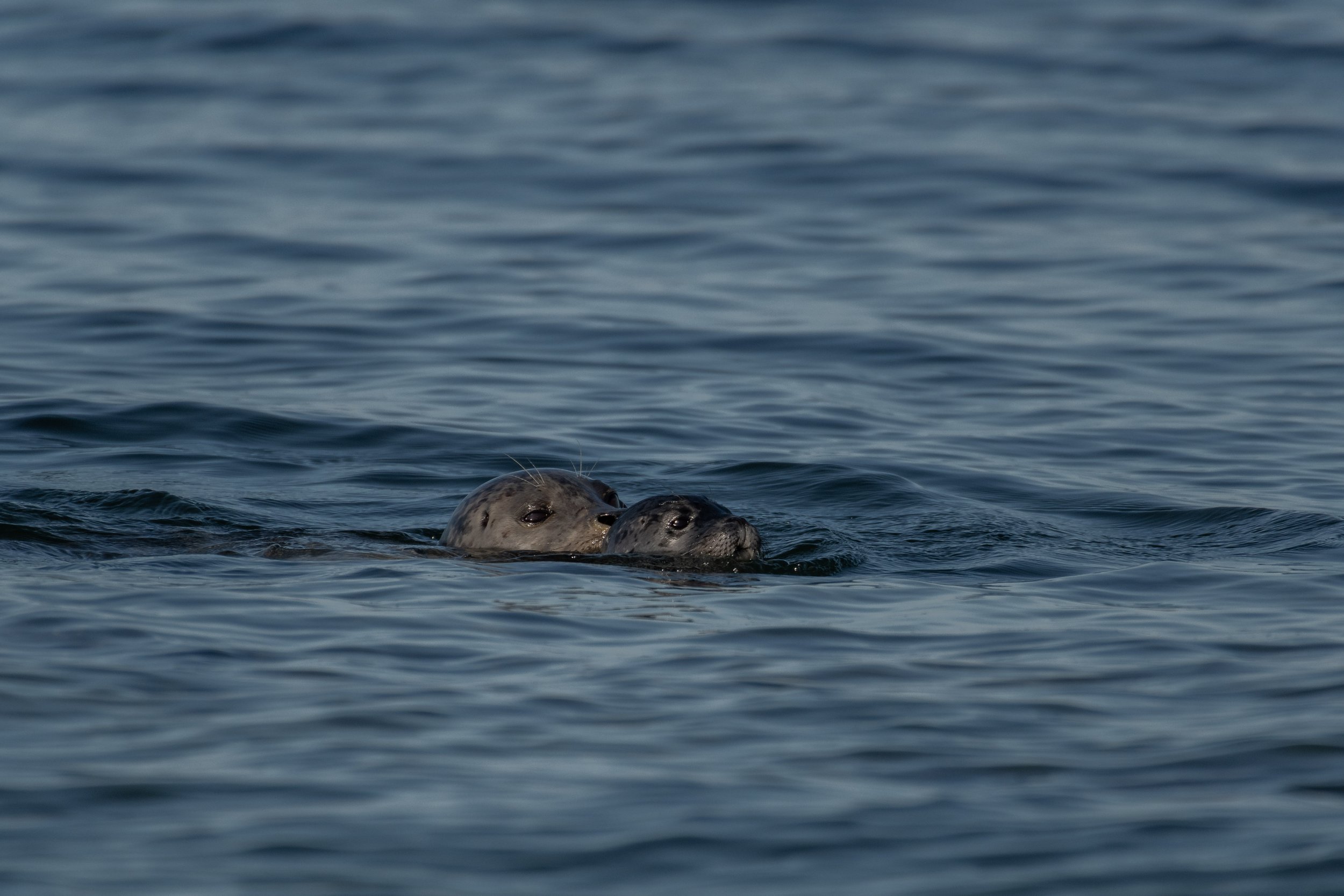August 3, 2024, 3:30 PM - Humpback party in the Strait
We had beautiful calm seas as two of our boats headed out of the harbour this afternoon. After a morning filled with humpbacks, we were almost certain we could find some of them again.
While we’re on the water, we’re constantly scanning the horizon for signs of whales. For humpbacks, the first thing we usually see is the blow. That can look like a smoke stack coming off the surface and is around 3 meters tall. You can see it from over a mile away! We also scan for their dorsal fins rising out of the water, or their fluke, which can be 20 feet from tip to tip! Occasionally if they breach or create any sort of splash, we can spot them that way as well.
Today, it wasn’t too long before we spotted our first blows! These belonged to Malachite (KEY0047), Slice (BCX1057 calf 2021), and Callisto (BCX0854calf2021)! This is an interesting trio as all 3 humpbacks are the same age. Most of the time, we have no idea how old whales are - however, all 3 of these whales were originally seen travelling alongside their mothers back in 2021. It seemed like Malachite was having a blast when we arrived on the scene, with a ton of tail slapping happening. You might be able to guess was tail slapping entails from the name. It is when the humpback whales lift their tail out of the water, sometimes as they are swimming normally or sometimes they are upside-down, and they bring that huge tail crashing back down. It seems like when the whales are doing this, they might be trying to “loosen things up” in their digestive system, since we often see them pooping while they do it. Looking through our photos this was the case with Malachite, as we saw the telltale signs of defecation in the water, the red plume of krill-filled poop! Even if it was a bathroom-driven event, it was still very interesting to watch!
After departing these three, our vessels went back into search mode to try and locate more whales. It didn’t take too long to find another pair close to Halibut Bank - these two were identified as Sage (BCX2073) and Velvet (BCY1186) travelling together and fluking. Associations like this seem to be common around the Salish Sea these days, as a lot of the humpbacks that we see seem to be paired up. These associations are usually short-term, lasting for only a few hours before they go their own ways, or trade out for another partner. Sometimes it can be a bit longer, a few days to weeks but most humpbacks seem to be more fickle than others. It seems to depend on the personality of the whales themselves, as some we notice are more likely to be paired up than others.
After visiting these two our boats split up in search of other whales. They were both lucky and found their own whales to watch!
After this pair, our Semi-covered vessel Kula then found Trooper (BCX1854) travelling solo, feeding away with a picture-perfect Mt.Baker in the background. Not even 5 minutes later they found ANOTHER humpback too - this one was identified as Bullet (BCX1658) who was also happily fluking away. It’s always amazing whenever we can locate and watch our humpbacks as they were previously thought to be extirpated (locally extinct) from our area, but to find 6 back to back within an hour is phenomenal!
The next whale that was spotted on this adventure was Beak (BCX1606) travelling solo! Beak seemed to have some extra energy as well, as we saw him breaching and slapping his massive pectoral fins onto the water. While we aren’t 100% sure why the whales will do this one of the leading theories is that it’s fun! It sure seemed that way while we were watching Beak here anyways.
Both boats ended up stopping for other wildlife with one going to Stinky Rocks and the other to the White Islets, both being Haul-out sites for the Steller Sea Lions and some Harbour Seals. Due to the high tides we didn’t see much of the seals, just their shiny heads sticking out of the water!
On the way back to Nanaimo, one of our boats came cross three other whales, just stopping for long enough to snap a photo to get an ID and figured out that it was Tempest (BCX0837) and her calf seen first, shortly followed by a fluke from Polyphemus (BCZ0342).
The onboard naturalists Aly Kohlman and Vanessa Vereschahen managed to snap some amazing photos of the whales and other wildlife during the tour, all of which can be viewed below!
Malachite flicking his tail. Photo by Aly Kohlman.
Malachite upside down flicking his tail and pectoral fin. Photo by Aly Kohlman.
Look at all the water coming off of Malachite’s tail. Photo by Aly Kohlman.
A big fluke waterfall Photo by Aly Kohlman.
The tip of Malachite’s pectoral fin! Photo by Aly Kohlman.
Malachite was very surface active today. Photo by Aly Kohlman.
A big tail flick from Malachite. Photo by Aly Kohlman.
Malachite diving with a waterfall off his fluke. Photo by Vanessa Vereschahen.
Malachite moving massive volumes of water with his tail. Photo by Vanessa Vereschahen.
A tail flip from Malachite. Photo by Vanessa Vereschahen.
Slice. Photo by Vanessa Vereschahen.
Malachite travelling belly up. Photo by Vanessa Vereschahen.
Malachite creating a fluke waterfall in a way we don’t usually see. Photo by Vanessa Vereschahen.
Look at all that water coming off Malachite’s tail! Photo by Vanessa Vereschahen.
Malachite doing a high fluke. Photo by Vanessa Vereschahen.
Malachite defecating! Photo by Vanessa Vereschahen.
Malachite. Photo by Vanessa Vereschahen.
Callisto’s dorsal fin. Photo by Aly Kohlman.
Callisto diving. Photo by Aly Kohlman.
Velvet lifting their tail to dive. Photo by Vanessa Vereschahen.
Velvet fluking. Photo by Vanessa Vereschahen.
Sage starting a dive. Photo by Vanessa Vereschahen.
Sage fluking. Photo by Vanessa Vereschahen.
Velvet’s fluke. Photo by Vanessa Vereschahen.
Bullet travelling. Photo by Aly Kohlman.
Bullet’s fluke. Photo by Aly Kohlman.
A look at half of Trooper’s tail fluke. Photo by Aly Kohlman.
Trooper with Mt. Baker in the background. Photo by Aly Kohlman.
Trooper fluking. Photo by Aly Kohlman.
Beak slapping his pectoral fins. Photo by Vanessa Vereschahen.
Both of Beak’s pectoral fins in the air as he swims upside down. Photo by Vanessa Vereschahen.
Look at the size of Beak’s pec! Photo by Vanessa Vereschahen.
Beak making a fluke waterfall as he dives. Photo by Vanessa Vereschahen.
A bald eagle keeping a watchful eye. Photo by Aly Kohlman.
Another look at the Bald Eagle. Photo by Aly Kohlman.
A River Otter watching us. Photo by Aly Kohlman.
A mother and pup Harbour seal pair. Photo by Aly Kohlman.
Getting side eyed by the Steller sea lions. Photo by Aly Kohlman.
You never know what the Stellers will get up to at Stinky Rocks! Photo by Aly Kohlman.
Tempest fluking. Photo by Aly Kohlman.
Polyphemus’ beautiful fluke. Photo by Aly Kohlman.
Steller Sea Lions at the White Islets. Photo by Vanessa Vereschahen.
A small flock of Black Oystercatchers. Photo by Vanessa Vereschahen.
A Black Oystercatcher preening. Photo by Vanessa Vereschahen.












































